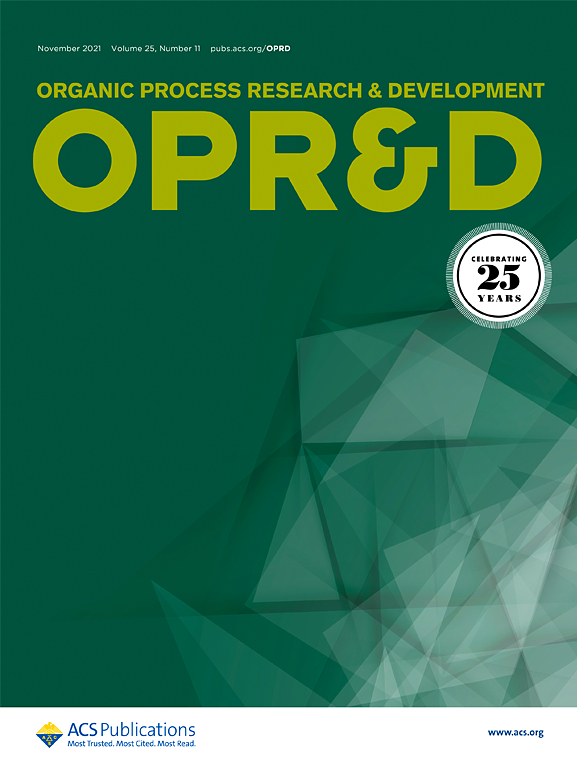制备Sotorasib关键中间体的改进工艺的发展
IF 3.5
3区 化学
Q2 CHEMISTRY, APPLIED
引用次数: 0
摘要
Sotorasib是一种一流的KRASG12C抑制剂,具有独特的碳氮退聚体。本文描述的是一种改进的第二代工艺的发展,以制造关键的sotorasib中间体rac-4。第二代工艺的显著改进包括在乙腈中开发了三步全伸缩序列,并使用光气作为异氰化剂,这使得二氯甲烷、水萃取和蒸馏完全从该工艺中去除。与第一代工艺相比,这些工艺改进使有机溶剂使用量减少了97%,废水产生量减少了71%,并且在整个工艺中仍保持了75%的收率和99.5%的rac-4纯度。本文章由计算机程序翻译,如有差异,请以英文原文为准。

Development of an Improved Process To Prepare a Key Intermediate in the Manufacture of Sotorasib
Sotorasib is a first-in-class KRASG12C inhibitor with a unique carbon–nitrogen atropisomer. Described herein is the development of an improved second-generation process to manufacture a key sotorasib intermediate, rac-4. Notable improvements to the second-generation process include the development of a three-step fully telescoped sequence in acetonitrile and the use of phosgene as an isocyanating agent, which allowed for dichloromethane, aqueous extractive work-ups, and distillations to be completely removed from the process. Compared to the first-generation process, these process improvements led to a 97% reduction in organic solvent usage and a 71% reduction in wastewater generation and still maintains a 75% yield and >99.5% purity of rac-4 in the overall process.
求助全文
通过发布文献求助,成功后即可免费获取论文全文。
去求助
来源期刊
CiteScore
6.90
自引率
14.70%
发文量
251
审稿时长
2 months
期刊介绍:
The journal Organic Process Research & Development serves as a communication tool between industrial chemists and chemists working in universities and research institutes. As such, it reports original work from the broad field of industrial process chemistry but also presents academic results that are relevant, or potentially relevant, to industrial applications. Process chemistry is the science that enables the safe, environmentally benign and ultimately economical manufacturing of organic compounds that are required in larger amounts to help address the needs of society. Consequently, the Journal encompasses every aspect of organic chemistry, including all aspects of catalysis, synthetic methodology development and synthetic strategy exploration, but also includes aspects from analytical and solid-state chemistry and chemical engineering, such as work-up tools,process safety, or flow-chemistry. The goal of development and optimization of chemical reactions and processes is their transfer to a larger scale; original work describing such studies and the actual implementation on scale is highly relevant to the journal. However, studies on new developments from either industry, research institutes or academia that have not yet been demonstrated on scale, but where an industrial utility can be expected and where the study has addressed important prerequisites for a scale-up and has given confidence into the reliability and practicality of the chemistry, also serve the mission of OPR&D as a communication tool between the different contributors to the field.

 求助内容:
求助内容: 应助结果提醒方式:
应助结果提醒方式:


